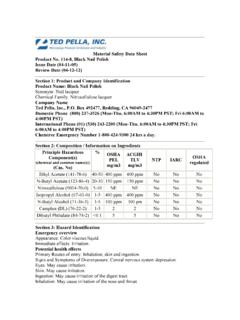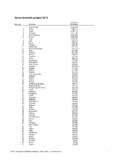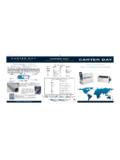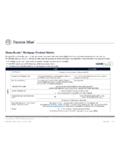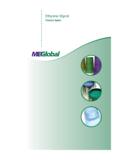Transcription of Chromate Coating for Aluminum Product Code …
1 IRIDITE 14-2 Chromate Coating for Aluminum Product code No. 78659 DESCRIPTION Iridite 14-2 is a chemical process that produces a protective Chromate conversion film on Aluminum and Aluminum alloys. Application is by dip, brush, swab, or spray, producing coatings ranging from clear to dark yellow. The darker coatings providing the greatest corrosion protection. The Coating can be used as a final finish or can be dyed various colors. It can also serve as a base for paints and high performance top coats, lacquers, or as a base for rubber bonding. The operating range of Iridite 14-2 is extremely flexible. Suitable adjustments of the Iridite 14-2 concentration can accommodate wide variations in immersion time, the corrosion protection (film thickness) desired, and the alloy to be treated.
2 FEATURES Coating has minimum effect on electrical characteristics of Aluminum for high or low frequency work when used at lower concentrations Coating protects abraded anodized surfaces and also provides electrical contact to those surfaces Coated Aluminum surface can be welded by shielded arc method or by spot welding Bath activators are self-regulating, providing maximum uniformity of results and ease of control Qualified under Specification MIL-DTL-81706B, Class 1A, Form II, Method A, B, C; and under Class 3, Form II, Method C. The clear Iridite 14-2 finish also qualifies under Class 3, Form II, Method C of the same specification. (Specification MIL-DTL-81706B qualifies products for use in conforming to Specification MIL-C-5541E) TYPICAL PROCESS CYCLE 1. Clean (as recommended) 2. Warm or cold running rinse 3. Iridite 14-2 4. Cold running rinse 5.
3 Hot water rinse * 6. Dry * Optional: See Rinsing & Drying Procedures on Page 10. MACDERMID INCORPORATED 245 FREIGHT ST. WATERBURY, CT USA 06702-9984 TEL (203) 575-5700 US FAX (203) 575-5630 INTERNATIONAL FAX (203) 575-7900 INCORPORATED Iridite 14-2 (78659) 07/07/2005 Page 2 EQUIPMENT Tank: Use 304 stainless steel, or use mild steel lined with polyethylene or Koroseal, or equal. Heating: Use 316 stainless steel for heating coils. Agitation: Agitation is not required in the bath other than to free entrapped air bubbles. However, moderate agitation, either mechanical or with clean air, improves Coating uniformity and accelerates Coating reaction slightly. Ventilation: Adequate local ventilation is required. SOLUTION MAKE-UP 1. Fill tank full with water. 2. Heat water to about 120 F (49 C). Do not exceed 120 F (49 C). 3. Add required quantity of Iridite 14-2 compound, while stirring.
4 Iridite 14-2 concentration should not exceed 4 oz/gal (30 g/L). 4. Heat (or cool) working solution to required operating temperature. OPERATING CONDITIONS Cleaning Prepare metal as recommended in Cleaning Cycles, Page 6-9. Operating Conditions Iridite 14-2 - 2 oz/gal ( - 17 g/L) Solution temp 60 -100 F (16 -38 C) Immersion time 30 sec. - 6 min Concentration pH Range g/L ( oz/gal) conc. (1 oz/gal) conc. 17 g/L (2 oz/gal) conc. Yellow Coating Generally, a yellow Coating for maximum protection is obtained using an Iridite 14-2 concentration of 1 oz/gal ( g/L) and a 3- to 6-minute immersion time. Higher concentrations and/or temperatures reduce immersion time necessary to produce a comparable film thickness. Coating color varies to some extent with the alloy treated. For example, coatings on soft alloys, such as 3003 and 5052, tend to be dark in color.
5 Coatings on 6061, 7075, and die cast alloys tend to be light in color. The immersion time selected should take this variation into consideration. Excessive immersion times cause a loose powdery Coating . Best results on high-silicon cast alloys are obtained using an Iridite 14-2 concentration of g/L ( oz/gal) and a 3- to 5-minute immersion time. Iridite 14-2 (78659) 07/07/2005 Page 3 Clear Coating A protective clear finish is obtained by first forming the normal yellow Coating , using an Iridite 14-2 concentration of 1 oz/gal ( ) and a 30-second to 3-minute immersion time. The work is then cold water rinsed, followed immediately by prolonged immersion in a final hot water rinse, which bleaches out the yellow color. At a rinse temperature of 200 F (93 C) one minute immersion is sufficient. As the temperature is lowered, immersion time must be increased.
6 Do not use an immersion time in excess of that necessary to remove the yellow color since this reduces the protective value of the film. Cleaning If cleaner is to be applied by spray, your MacDermid representative will recommend a suitable low-foaming cleaner. Otherwise, prepare metal as recommended in Cleaning Cycles, page 6-9. Operating Conditions Iridite 14-2 1-2 oz/gal ( g/L) Solution temp 60 -120 F (16 -49 C) Spray time 15 sec. - 3 min. pH range Spray pressure 5-50 psi ( kPa) Note: Spray nozzles and pressure may vary to suit application. All nozzles and headers must be made of acid resisting material. Operating Data for Brush and Swab Application Note: The Iridite 14-2 Brush-On Kit can be used for touch-up work on small parts. The kit contains all the necessary chemicals to clean and Iridite coat about 1000 ft 2 (93 m2) of Aluminum surface.
7 Detailed instructions are in the Iridite 14-2 Brush-On Kit technical bulletin. Cleaning Methods Degreasing: Degrease heavily soiled work with a solvent wash, then acid clean. For lightly soiled or fingerprinted work, acid cleaning alone should be sufficient. Acid Cleaning: Apply the following solution with brush or swab until water breaks disappear and surface is completely wet. Rinse thoroughly before applying Iridite 14-2. Isoprep 188 6-8 oz/gal (45-60 g/L) ARP 2 detergent 1 fl oz/gal (10 mL/L) Solution temp. 70 -90 F (21 -32 C) Mechanical Cleaning: Sanded, ground, wire brushed, or freshly cut surfaces may be treated with Iridite 14-2 without cleaning provided treatment is accomplished immediately. Operating Conditions Iridite 14-2 1 -4 oz/gal ( g/L) Solution temp. 60 -100 F (16 -38 C) Concentration pH range: 1 oz/gal ( g/L) conc. 2 oz/gal (17 g/L) conc.
8 4 oz/gal (30 g/L) conc. Iridite 14-2 Application Iridite 14-2 (78659) 07/07/2005 Page 4 Iridite 14-2 solution can be applied by swab, brush or flowcoat. A single application is the equivalent of 5 to 10 seconds treatment by immersion. Usually, the film produced by a single application is light in color. Repeated applications of fresh solution increase film thickness to where a golden yellow to brown color appears, and also increase the protective value of the Coating . Faster results can be obtained using a concentration of 30g/L (4 oz/gal) producing a yellow Coating in 15 to 30 seconds. ARP 2 detergent can be added to the solution at the rate of 1 gal/100 gal (1 L/100 L) of working solution if the surface is difficult to coat. SOLUTION CONTROL & MAINTENANCE Control By pH and Titration pH is the most critical factor in solution control. An increase in pH causes a lightening in film color, while a decrease in pH causes a darkening in color.
9 In the extreme cases, too high a pH gives no Coating at all; while too low a pH gives a loose and powdery Coating . For most accurate control, use both the hexavalent chromium determination (described in Analytical Control, page 5) and pH measurement. The result is more economical operation and the ultimate in Product uniformity. By this procedure, Iridite 14-2 compound is added to the bath to adjust concentration. When this addition does not bring pH within the operating range, further pH adjustment is made with nitric acid (42 B ). A nitric acid (42 B ) addition of 13 fl oz per 100 gallons (100 mL/100L) of working solution lowers the pH about unit. Too low a pH can be corrected by small additions of caustic soda. The addition of 1 lb/100 gals (60g of caustic soda per 100 liters) of working solution raises pH by about units. Since Iridite 14-2 solution ages during use, the Coating obtained becomes gradually lighter in color even though constant operating conditions are maintained.
10 If this occurs, restore solution to normal operation by gradually increasing the Iridite 14-2 concentration within the range given and lowering the pH limit below the range specified. Control By pH Only By this method, pH alone is measured. A dual maintenance addition of Iridite 14-2 and nitric acid (42 B ) at the following rate will lower pH approximately unit. Caution: Add the components separately to the bath. DO NOT mix the nitric acid with the Iridite 14-2 powder. per per 100 gal 100 L Iridite 14-2 1 lb 120 g Nitric acid (42 B ) fl oz 24 mL Repeat this dual addition, if necessary, until pH is within operating range. If the coatings are too light, even though pH is within the optimum range, make further additions in the above preparations to lower the pH to below the range specified. Control By Color of Finish Where analytical equipment is not available, a very simple method can be used to determine if the solution is in satisfactory working order.

